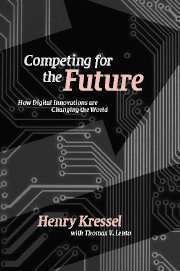Book contents
- Frontmatter
- Contents
- List of figures
- List of tables
- Acknowledgements
- Introduction
- Part I The technology – how electronic devices work – digital systems and software
- Part II Innovators, entrepreneurs, and venture capitalists
- 3 Edison's legacy: Industrial R&D
- 4 R&D goes global
- 5 Financing innovation: Venture capital
- Part III Global reach, global repercussions
- Appendix 1.1 Smaller, faster, more efficient MOSFETs
- Appendix 1.2 Building multi-transistor logic gates
- Appendix 1.3 MOSFETs in memory devices
- Appendix 1.4 CMOS reduces logic gate power dissipation
- Appendix 1.5 Laser diode basics
- Appendix 1.6 Light-emitting diodes (LEDs)
- Appendix 1.7 Photodetectors
- Appendix 1.8 Making fiber optic cables
- Appendix 1.9 Principles of LCD displays
- Appendix 2.1 The demise of analog computers
- Appendix 2.2 IP, TCP, and the Internet
- Appendix 2.3 Building an object-oriented program
- Index
3 - Edison's legacy: Industrial R&D
from Part II - Innovators, entrepreneurs, and venture capitalists
Published online by Cambridge University Press: 07 December 2009
- Frontmatter
- Contents
- List of figures
- List of tables
- Acknowledgements
- Introduction
- Part I The technology – how electronic devices work – digital systems and software
- Part II Innovators, entrepreneurs, and venture capitalists
- 3 Edison's legacy: Industrial R&D
- 4 R&D goes global
- 5 Financing innovation: Venture capital
- Part III Global reach, global repercussions
- Appendix 1.1 Smaller, faster, more efficient MOSFETs
- Appendix 1.2 Building multi-transistor logic gates
- Appendix 1.3 MOSFETs in memory devices
- Appendix 1.4 CMOS reduces logic gate power dissipation
- Appendix 1.5 Laser diode basics
- Appendix 1.6 Light-emitting diodes (LEDs)
- Appendix 1.7 Photodetectors
- Appendix 1.8 Making fiber optic cables
- Appendix 1.9 Principles of LCD displays
- Appendix 2.1 The demise of analog computers
- Appendix 2.2 IP, TCP, and the Internet
- Appendix 2.3 Building an object-oriented program
- Index
Summary
What makes the capitalist system work, what keeps economies dynamic, is precisely nonconformity, the new, the unusual, the eccentric, the egregious, the innovative, springing from the inexhaustible inventiveness of human nature.
Most of the revolutionary innovations in semiconductors and software explored in the preceding two chapters came out of the corporate R&D organizations of AT&T, General Electric, IBM, Corning, RCA, and other large companies.
That doesn't mean these breakthroughs reflect a corporate mindset. Nothing could be further from the truth. The scientists who created them were following their own paths, not some managerial directive or mandated marketing strategy. As someone who began his career in this environment, I can attest to its creative ferment.
Truly creative people tend to be free spirits. They are the essential spark plugs of innovation. At the same time, their drive for discovery is often in conflict with practical considerations such as company direction or fiscal constraints. This trait presents corporate R&D managers with endless challenges.
Perhaps that is why the talk today is all about “small, innovative companies,” not big, powerful corporate laboratories (labs). But the fact is that for much of the twentieth century those big labs were the primary generators of new technology, because they had the resources and the funding necessary for research. They were the vehicles innovators needed to carry their work forward.
We've begun our study of digital electronics by looking at how the technology works, and how it affects people and businesses.
- Type
- Chapter
- Information
- Competing for the FutureHow Digital Innovations are Changing the World, pp. 101 - 121Publisher: Cambridge University PressPrint publication year: 2007



